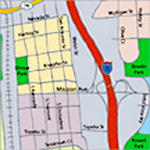What procedures might Ms. Lin suggest?
Page 3: Self-regulated Strategy Development
Ms. Lin, the lead fourth-grade teacher, listens to Mr. Carter’s concern that some of his students do not complete their assignments. She suggests that his students might benefit from learning a writing strategy. Explaining that it is critical for Mr. Carter to use explicit instruction to teach a writing strategy to his students, Ms. Lin introduces him to Self-Regulated Strategy Development (SRSD). SRSD, Ms. Lin explains, provides a framework for teaching instructional strategies and self-regulation strategies.
explicit instruction
Instructional approach in which teachers clearly identify the expectations for learning, highlight important details of the concept or skill, offer precise instruction, and connect new learning to earlier lessons and materials.
SRSD Model
 A scientifically validated framework for explicitly teaching academic strategies to students, SRSD incorporates steps that have been shown to be critical if students are to learn how to effectively use academic strategies. When teachers implement SRSD, students are more likely to be successful at mastering academic tasks. The SRSD model involves six stages:
A scientifically validated framework for explicitly teaching academic strategies to students, SRSD incorporates steps that have been shown to be critical if students are to learn how to effectively use academic strategies. When teachers implement SRSD, students are more likely to be successful at mastering academic tasks. The SRSD model involves six stages:
- Develop Background Knowledge
- Discuss It
- Model It
- Memorize It
- Support It
- Establish Independent Practice
As they move through these stages, teachers might find it necessary to repeat some of them, whereas at other times they are able to move from stage to stage more quickly. Whatever the case, it is important that teachers understand that the steps are recursive—that is, teachers and students can return to any stage at any point in time.

To better understand why you should teach strategies instruction, consider the analogy of a roadmap. When you go on a road trip, you often take along a map to help you to avoid making wrong turns and getting lost. Like a roadmap, SRSD gives you specific steps and sequences to use when you teach strategies to your students
 Students who struggle in academic areas may need more than an instructional strategy; they may need a means through which to regulate their own behavior. The SRSD approach provides students with such a means. Through SRSD, teachers help students to learn four basic self-regulation strategies:
Students who struggle in academic areas may need more than an instructional strategy; they may need a means through which to regulate their own behavior. The SRSD approach provides students with such a means. Through SRSD, teachers help students to learn four basic self-regulation strategies:
goal setting
An instructional process that includes:
- Setting goals and breaking them into steps as needed
- Developing plans for meeting goals and monitoring progress
- Implementing the plans
- Self-monitoring
- Revising the goals when needed
The goal-setting strategy helps students to understand what they are striving for. Used with writing strategies, it can increase student attention, motivation, and effort.
self-monitoring
A strategy of self-regulation that is used to help students determine whether a behavior exists. It consists of two parts, self-assessment and self-recording. Self-monitoring increases or decreases the frequency, intensity, or duration of the existing behavior. In conjunction with writing strategies, it can be used to evaluate and monitor student attention, performance, and strategy use.
self-instruction, self-talk, or self-statements
A strategy by which students learn to talk themselves through a task or activity. It uses language to direct or control behavior. Self-instruction can help students learn to consciously understand or overcome a problem. When it is used in conjunction with writing strategies, students can tell themselves what to write next, that they should focus their thinking on the task at hand, and that they ought to remain positive.
self-reinforcement
Method through which students reinforce or rewards themselves for reaching or exceeding a criterion. Self-reinforcement creates greater changes than are possible through teacher-led reinforcement. When used with writing strategies, self-reinforcement typically consists of using positive self-statements (e.g., “I’ve finished writing three paragraphs. Now I only have my concluding paragraph left to write. I’m proud of myself for doing a good job of staying focused on my task.”)